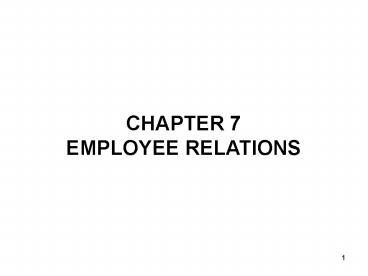CHAPTER 7 EMPLOYEE RELATIONS - PowerPoint PPT Presentation
Title: CHAPTER 7 EMPLOYEE RELATIONS
1
CHAPTER 7EMPLOYEE RELATIONS
2
UNDERSTANDING EMPLOYEE RELATIONS
- Good employee relations involve providing fair
and consistent treatment to all employees - To foster good employee relations, managers must
listen to and understand what employees are
saying and experiencing
3
UNDERSTANDING EMPLOYEE RELATIONS
- Effective employee relations require cooperation
between managers and employee relations
representatives - ERR will try to ensure that company policies and
procedures are followed and advise both
supervisors and employees on specific employee
relations problems
4
TRADE UNIONS
- A group of seven or more workers can form a trade
union - Application for registration with DG of Trade
Unions - The application form must be signed by all
members - Send together with the unions constitution
- The important criterion for a union to be
registered is its intended member
5
TRADE UNIONS
- All workers above 16 years have the right to join
an appropriate union - Workers between 16 and 21 have lesser rights to
participate in union activities - Specified groups of workers are restricted from
joining trade unions
6
TYPES OF UNIONS
- National and regional unions
- In-house unions
- Employers associations
7
ROLE OF TRADE UNIONS
- Protect their members right
- Will take action to stop such unfair practices
- Advise members on their right
- Encouraging government to pass legislation
- Introduce policies
- Three-pronged approach
- Individual employers
- National issues
- Individual members
8
COLLECTIVE BARGAINING
- The process whereby employers and employees
negotiate over the terms and conditions on
employment - Union is required by law to gain formal
recognition from the employer before any
negotiation can be made
9
COLLECTIVE BARGAINING
- One of the main functions of trade unions
- The best method of regulating the terms and
conditions of employment - Once an agreement is reached between the two
parties, there will be no discrimination between
them
10
COLLECTIVE BARGAINING
- May be carried out between an individual employer
and a trade union of employees - Or between the union of employees and the union
of employers - This process is regulated by the Industrial
Relation Act
11
COLLECTIVE AGREEMENTS
- Written agreement between an employer and a trade
union relating to terms and conditions of
employment - Agreement must specify their duration, not less
than three years - Must be deposited with Industrial Court
- Most agreements include clauses on wages, working
hours and other benefits to be given to the
workers
12
INDUSTRIAL ACTION
- Picket
- Strike
- Lockout
13
SETTLEMENT OF INDUSTRIAL DISPUTES
- Conciliation
- Arbitration
14
EMPLOYMENT LAWS
- Employment Act
- Industrial Relations Act
15
DISCIPLINE
- Penalties in a disciplinary system
- Oral warning
- First written warning
- Final written warning
- Suspension without pay
- Suspension of increment
- Demotion or downgrading
- Dismissal
16
EMPLOYEE PROBLEMS
- Transfer
- Promotion of employees
- Grievance handling
- Absenteeism of workers
17
TERMINATION OF EMPLOYEES CONTRACT OF EMPLOYMENT
- Role of Industrial Court
- Resignation
- Expiry of fixed-term contract
- Retirement
- Redundancy and retrenchment
18
TERMINATION OF EMPLOYEES CONTRACT OF EMPLOYMENT
- Dismissal of misconduct
- Dismissal for poor performance
- Frustration of contract
- Termination of probationers
- Constructive dismissal
19
CHAPTER 8SAFETY AND HEALTH
20
ACCIDENTS AT WORK
- Financial costs
- Losses of output
- Lowered morale
- Negative publicity
21
TYPES OF ACCIDENTS
- Near miss
- Non-fatal
- Fatal
22
CAUSES OF ACCIDENTS
- Technical causes
- Human causes
- Environmental causes
23
ENSURING A SAFE WORKPLACE
- Safety policies
- A statement of organizations commitment
- An explanation of whos responsible
- A description of procedures
- Safety programmes
- Commitment from all employees
- Officer in-charge of safety
24
ENSURING A SAFE WORKPLACE
- Safety programmes
- Record keeping
- Safety training
- Safety and healthy living campaigns
- Incentive and reward schemes
- Provision of personal protective equipment
- Disciplinary system
25
OCCUPATIONAL SAFETY AND HEALTH ACT
- Ensure the safety of all employees and any other
person at the workplace - Draft and disseminate a safety policy
- Appoint a safety committee
- Appoint a dedicated, qualified safety and health
officer - Provide appropriate training, supervision and
information - Report serious accidents to DOSH
26
SEXUAL HARASSMENT
- An unwanted conduct of a sexual nature having the
effect of verbal, non-verbal, visual,
psychological or physical harassment - Not acceptable behaviour and any employee found
guilty of such conduct will be punished
27
IMPROVING EMPLOYEES HEALTH
- Wellness programmes
- Stress management
- Reducing drug and alcohol related problems
28
EMPLOYEE ASSISTANCE PROGRAMS
- Programs designed to help employees whose job
performance is suffering because of physical,
mental or emotional problems - Four steps involve
- Identify troubled employee
- EAP counseling
- Solve the problem
- Depend on the outcome of the treatment































